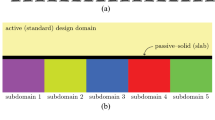Abstract
We applied a shape optimization algorithm based on an explicit interface tracking method to optimize underground caverns. The objective chosen in the present work is to minimize the strain energy. The algorithm can search the optimized solution in a large design space automatically, achieve large-scale shape deformation, and obtain smooth boundaries in the optimized shapes. Through the numerical examples, we verify the feasibility of the method applied in the underground cavern optimization, and more importantly, investigate the influence of the distribution of in situ stresses and the bedding properties on the optimized shape of the underground caverns.















Similar content being viewed by others
References
Le, C., Bruns, T., Tortorelli, D.: A gradient-based parameter-free approach to shape optimization. Comput. Methods Appl. Mech. Eng. 200(9–12), 985–996 (2011)
Lian, H., Kerfriden, P., Bordas, S.P.A.: Implementation of regularized isogeometric boundary element methods for gradient-based shape optimization in two-dimensional linear elasticity. Int. J. Numer. Meth. Eng. 106(12), 972–1017 (2016)
Lian, H., Kerfriden, P., Bordas, S.P.A.: (2017) Shape optimization directly from CAD: an isogeometric boundary element approach. Comput. Methods Appl. Mech. Eng. 317, 1–41 (2017)
Allaire, G., Jouve, F., Toader, A.M.: Structural optimization using sensitivity analysis and a level-set method. J. Comput. Phys. 194(1), 363–393 (2004)
Wang, M., Wang, X., Guo, D.: A level set method for structural topology optimization. Comput. Methods Appl. Mech. Eng. 192(1), 227–246 (2003)
Bendøe, M.P., Sigmund, O.: Topol. Optim. Theory Methods Appl., 2nd edn. Springer Verlag, Berlin (2003)
Misztal, M.K., Bærentzen, J.A.: Topology adaptive interface tracking using the deformable simplicial complex. ACM Trans. Graph. 31(3), 1–12 (2012)
Christiansen, A.N., Nobel-Jørgensen, M., Aage, N., Sigmund, O., Bærentzen, J.A.: Topology optimization using an explicit interface representation. Struct. Multidiscip. Optim. 399, 387–399 (2014)
Christiansen, A.N., Bærentzen, J.A., Nobel-Jørgensen, M., Aage, N., Sigmund, O.: Combined shape and topology optimization of 3D structures. Comput. Gr. 46, 25–35 (2015)
Lian, H., Christiansen, A.N., Tortorelli, D.A., Sigmund, O., Aage, N.: Combined shape and topology optimization for minimization of maximal von Mises stress. Struct. Multidiscip. Optim. 55, 1541–1557 (2017)
Lian, H., Aage, N., Sigmund, O.: Combined shape and topology optimization for stokes flow problems. In 11th world congress of structural and multidisciplinary optimization. Sydney, Australia (2015)
Zhou, M., Lian, H., Sigmund, O., Aage, N.: Shape optimization of fluid flow problems using an explicit boundary tracking approach. Int. J. Numer. Meth. Fluids 88(6), 296–313 (2018)
Svanberg, K.: The method of moving asymptotes - a new method for structural optimization. Int. J. Numer. Meth. Eng. 24(2), 359–373 (1987)
Acknowledgements
The authors are sincerely grateful for the support of the National Natural Science Foundation of China (Nos.51904202, 51904196).
Author information
Authors and Affiliations
Corresponding author
Additional information
Publisher's Note
Springer Nature remains neutral with regard to jurisdictional claims in published maps and institutional affiliations.
Rights and permissions
About this article
Cite this article
Lian, H., Wu, P. The shape optimization of underground caverns based on strain energy criterion via explicit interface tracking methods. Int J Adv Eng Sci Appl Math 12, 183–192 (2020). https://doi.org/10.1007/s12572-020-00281-7
Accepted:
Published:
Issue Date:
DOI: https://doi.org/10.1007/s12572-020-00281-7




